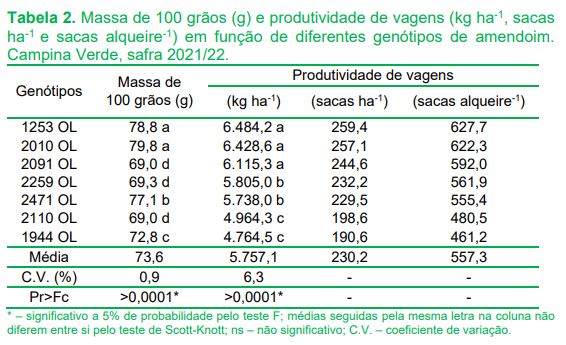Agronomic characteristics of new mid-cycle peanut lines in the Triângulo Mineiro
DOI:
https://doi.org/10.52755/sas.v3i2.189Keywords:
Arachis hypogaea L., Cerrado, Cultivars, ProductivityAbstract
The objective of this work was to evaluate the agronomic characteristics of mid-cycle peanut genotypes in Triângulo Mineiro. The experiment was installed in an area of sugarcane renewal, in the 2021/22 harvest, located in the municipality of Campina Verde – MG. The experimental design used was in randomized blocks, with four replications. The treatments were seven strains (1253 OL, 2010 OL, 2091 OL, 2259 OL, 2471 OL, 2110 OL and 1944 OL), developed by Embrapa's Peanut Improvement Program (PMA). The plots consisted of two lines of three meters in length, with an interval of three meters between plots and spacing between lines of ninety centimeters. After harvest at 125 days after planting (DAP), the weight of 100 grains and productivity were evaluated. It is concluded that the highest masses of 100 grains were obtained with 1253 OL and 2010 OL, while these same genotypes obtained the highest yields, together with 2091 OL, for the edaphoclimatic conditions of the Triângulo Mineiro. Emphasizing that studies with genetic improvement should continue in order to select genotypes that are increasingly productive and that meet the characteristics of the country's growing regions.
Downloads

Downloads
Published
How to Cite
Issue
Section
License
Copyright (c) 2022 Antonio Carlos Aparecido Filho, Amanda Severino Soares, Dener Cássio Ferreira Carneiro Júnior, Jair Heuert, Maxuel Fellipe Nunes Xavier, Taís de Moraes Falleiro Suassuna, Thiago Orlando Costa Barboza, Vítor Garcia Caporusso

This work is licensed under a Creative Commons Attribution-NonCommercial-ShareAlike 4.0 International License.
Autores concordam com os seguintes termos:
a) Os autores mantêm os direitos autorais e concedem à revista o direito de primeira publicação, com o trabalho simultaneamente licenciado sob a LicençaAttribution-NonCommercial-ShareAlike 4.0 International, que permite o compartilhamento do trabalho com reconhecimento da autoria e publicação inicial na Revista SAS. A licença permite o uso, a distribuição e a reprodução irrestrita, em qualquer meio, desde que devidamente citada a fonte. Essa licença permite também que outros remixem, adaptem e criem a partir do seu trabalho para fins não comerciais, desde que atribuam a você o devido crédito e que licenciem as novas criações sob termos idênticos.
b) Não cabe aos autores compensação financeira a qualquer título, por artigos ou resenhas publicados na South American Sciences.
c) Os conceitos expressos nos artigos publicados na South American Sciences são de inteira responsabilidade de seus autores.








